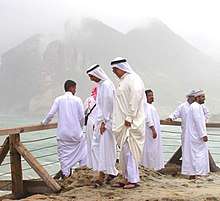Thawb
A thawb or thobe (Arabic: ثَوْب), also called a Qamīṣ (Arabic: قَمِيص Somali: khamis), is an ankle-length garment, usually with long sleeves, similar to a robe, kaftan or tunic. It is commonly worn in the Arabian Peninsula, Iraq, neighbouring Arab countries, the southern and south-western ports and Islands of Iran, and some countries in East and West Africa. A sirwal or pants, izaar or lungi are typically worn underneath.
Background
The word thawb is the standard Arabic word for 'a garment'. It is traditional clothing style for men. It is sometimes spelled thobe or thaub. It is a tunic, generally long. The word is used specifically for this garment in Arab States of the Persian Gulf and some areas in the south of Egypt. There has been some debate regarding the correct length of the thawb.
Prevalence
The thawb is commonly worn by men in the Arabian Peninsula, Iraq, and other Arab countries in the Persian Gulf. It is normally made of cotton, but heavier materials such as sheep's wool can also be used, especially in colder climates in Iraq and Syria.[1] The style of the thawb varies slightly among the various regions within the Persian Gulf region. The sleeves and the collar can be stiffened to give a more formal appearance. Other names may be used for this garment. In Iraq, Kuwait, the Levant, and Oman, dishdasha is the most common word for the garment; in the UAE, the word kandura is used. In Morocco, the sleeves tend to be much shorter so that the thawb may seem more like a long T-shirt and is locally called gandora. The neck also tends to be more open than in its Saudi counterpart and, along with the breast pocket, is often embroidered. It might also lack buttons altogether.
The term thawb is also used to refer to similar women's garments.[2]. In the lead up to Independence (1956–present), new styles of thobes became fashionable as Sudanese women "expressed their growing opportunities and desires through fashion."[3] The traditional Palestinian woman's long tunic is also a thobe. This style originated in the early 19th century and is richly embroidered, with different colours and patterns signifying various aspects of the wearer's social position.[4] Since the Nakba, or 1948 Palestinian exodus, the thobe has also come to represent Palestinian political identity.[4] Another example is a very long, oversized woman's garment with a heavily embroidered front panel and billowing back, also known as a Khaleeji dress, which is most commonly seen in the West worn for performance of the Saudi women's social-style dances, in which manipulation of the large thawb is a key component.
This garment is also known as Kanzu in Swahili, and is commonly worn on the Swahili Coast by Swahili men.
Name variations
| Region/country | Language | Main |
|---|---|---|
| Saudi Arabia, Bahrain & Palestine | Hejazi Arabic, Najdi Arabic, Bahraini Arabic, Palestinian Arabic | Thawb (ثَوْب), Thoeb |
| Levant, Iraq, Kuwait, Oman, Iran | Levantine, Iraqi, Khuzestani, Omani & Kuwaiti Arabic; Persian | Dishdāshah (دِشْدَاشَة), Deshdāsheh (دِشْدَاشِه) |
| UAE | Emirati/Gulf Arabic | Kandūrah (كَنْدُورَة) |
| Yemen | Yemeni Arabic | Thaob (ثَوْب) |
| Upper Egypt, Libya, Chad & Sudan | Upper Egyptian, Libyan, Chadian & Sudanese Arabic | Jilābiyah (جِلَابِيَة) |
| Maghreb | Maghrebi Arabic, Berber | Gandora, Djellaba (جِلَّابَة), Aselham |
| Greater Somalia | Somali | Khamiis, Jelabiyad, Qamiis |
| Ethiopia | Amharic, Afaan Oromoo | Jelebeeya, Mudawwar |
| Eritrea | Tigrinya | Jehllubeeya |
| Indo-Malay Peninsula | Indonesian, Malay | Jubah, Gamis |
| Afghanistan | Dari, Pashto | Pērâhan (پیراهن),(kharqay) |
| Pakistan, India | Urdu | Jubbah (جُبَّه) |
| Bengal | Bengali | Thub, Jubbah |
| Israel | Hebrew | Kethoneth (כתונת) |
| Turkey | Turkish | Cübbe, Savb, Sob |
| Swahili Coast | Swahili | Kanzu |
| Senegal | Wolof | Khaftaan, Mbubb |
Other occasions
A thawb is sometimes worn with a bisht (Arabic: بِشْت), also known in other parts of the Arabian Peninsula as a mishlah (Arabic: مِشْلَح) or ʿabāʾ (Arabic: عَبَاء), meaning 'cloak'. It is usually worn in ceremonial occasions or by officials. A bisht is usually worn by religious clergy, but can also be worn in a wedding, Eids and funerals. It may refer to a status of wealth and royalty, or sometimes a religious position. It was originally manufactured in Syria, Iraq and Jordan, and it is usually worn in Jordan, Syria, Iraq and the Arabian peninsula.
According to H. R. P. Dickson,[5] Bedouin women would mount a brightly coloured thawb on a pole in front of a tent in order to welcome home a traveller or an important person coming to visit.[2]
Rashida Tlaib, a Democratic member of the United States House of Representatives from Michigan and the first Palestinian-American woman elected to that body, wore a thawb to her swearing-in ceremony on January 3, 2019.[6] This inspired a number of Palestinian and Palestinian-American women to share pictures on social media with the hashtag #TweetYourThobe.[7]
See also
References
- Jirousek, Charlotte (2004). "Islamic Clothing". Art, Design, and Visual Thinking. Charlotte Jirousek. Retrieved May 25, 2019.
- Campbell, Kay Hardy; Corman, Leela (March–April 2016). "The Gown That Steals Your Heart". Aramco World. 67 (2): 24–25.
- "'Khartoum at Night' looks at Sudanese history through fashion". University of Kansas Department of History. University of Kansas. August 9, 2017. Retrieved May 25, 2019.
expressed their growing opportunities and desires through fashion.
- Debre, Isabel (February 12, 2019). "Iconic Palestinian robe fashions a new political symbol". AP News. Retrieved May 25, 2019.
- Dickson, H.R.P. (2015). The Arab of the desert : a glimpse into Badawin life in Kuwait and Sau'di Arabia. New York, NY: Routledge. OCLC 919302946.
- Jennings, Rebecca (January 4, 2018). "Rashida Tlaib's thobe and Ilhan Omar's hijab are making congressional history". Vox.
- Zrarick, Karen (January 3, 2018). "As Rashida Tlaib Is Sworn In, Palestinian-Americans Respond With #TweetYourThobe". The New York Times.
